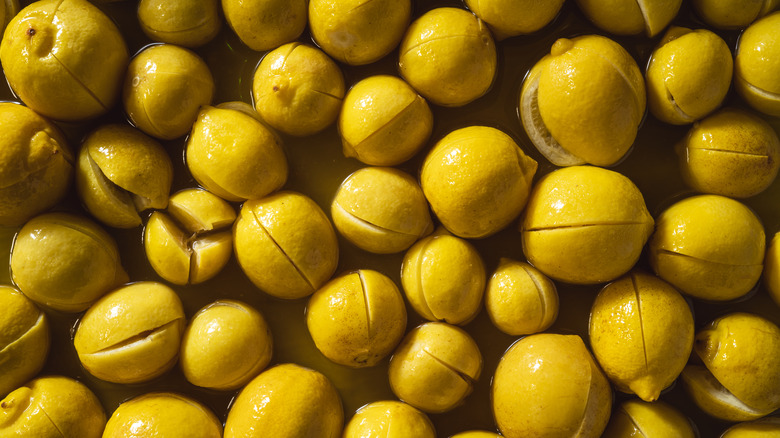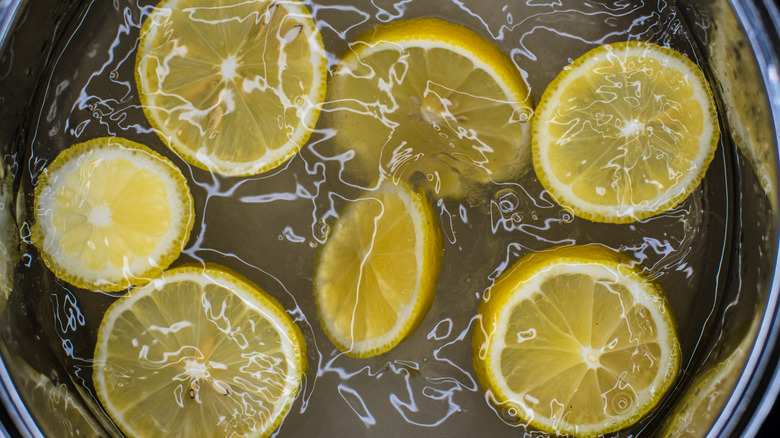Chef Brandon 'Sad Papi' Skier's Clever Hack For Making Citrus Fancy - Exclusive
Brandon Skier, or Sad Papi as he's known across Instagram and TikTok, has a reputation for making fancy dishes that feel utterly laidback and LA-cool. Recently, Skier channeled his years of experience cooking in some of LA's most well-regarded restaurants into a cookbook titled "Make It Fancy — Cooking At Home with Sad Papi." When asked what influenced the recipes in his book, Skier cites those years he spent apprenticing himself under the tutelage of California's culinarati. We recently chatted with Skier before the book launch in an exclusive interview for Mashed in which he shares the secrets to cooking avante-garde food at home that is as surprising and delightful as a meal at a high-end restaurant in Los Angeles.
During our conversation, Skier shared his technique for turning citrus into a versatile gel that can be used as an ingredient or garnish to infuse acid, funk, and flavor — aspects of a balanced dish that can elevate anyone's cooking. A recipe for a "gel" may conjure up an image of mid-aughts haute cuisine, or "tweezer food" as Skier calls it, with its extraneous foams and squeeze bottle streaks. Skier, however, who sports a black hoodie and a sleeve of tattoos, offers up an approach that's anything but stuffy. Perhaps one of the reasons for Skier's popularity is that his recipes invite followers into an exclusive club once reserved only for culinary's back-of-house elite. His preserved lemon gel is one such recipe.
Making preserved lemon gel
Brandon Skier makes his own preserved lemons by scoring the whole fruit, then packing them with salt and fermenting them. Skier likes preserved lemons for their taste, but for this technique, any citrus fruit will do. "I like doing it with preserved lemon in particular, just because it has that unique funky flavor, the floral flavor of a preserved lemon." Other fresh citrus will yield a similar result without the salt and funk. Oranges, blood oranges, or even grapefruit will yield a sweeter, more mellow-tasting gel.
To make the gel itself, he boils the fruit in simple syrup and then emulsifies it in a high-speed blender until it's thick and shiny. "All you're doing is blending lemons until they're hot, activating that pectin," says Skier. "There's no agar, there's no setting agent. You're just using the pectin which is already there."
Agar agar is a plant-based thickening agent that's often used as a substitute for gelatin. Another alternative is pectin, which is sold in powder form for jam-making. The clever cook, however, knows how to extract pectin naturally found in citrus peels. All citrus fruits — from the common lemon to the Japanese yuzu — contain a high amount of pectin. When high-pectin fruits are heated alongside acid and sugar, the starches bind, forming a gel. As Skier says, "With pectin comes power."
How Skier uses preserved lemon gel
"Once you understand what pectin is," says Brandon Skier, "You can take advantage of it and make something that looks fancy, but it's not." And once you've made this fancy-looking citrus gel, its applications are fairly endless. The preserved lemon gel is thick and yellow, like translucent lemon curd, and can be used to give dishes a flourish of brightness and acidity. Skier likes to use it in a similar application to lemon wedges, but unlike fresh juice, it has the added benefit of a thicker texture, so it won't get lost in a dish.
Skier's go-to use for preserved lemon gel is as an accompaniment for seafood, especially shellfish like raw oysters. "I put just a little drop ... because the [acid] reminds me of a mignonette, and a little bit of lemon and citrus going on, but in a different format." Skier adds that all fish — whether fresh, cured, or smoked — pairs well with the structure and sourness of preserved lemon gel. In his book, you'll find Skier squeezing the gel out of a pastry bag, making the dish, as he might say, "fancy."


